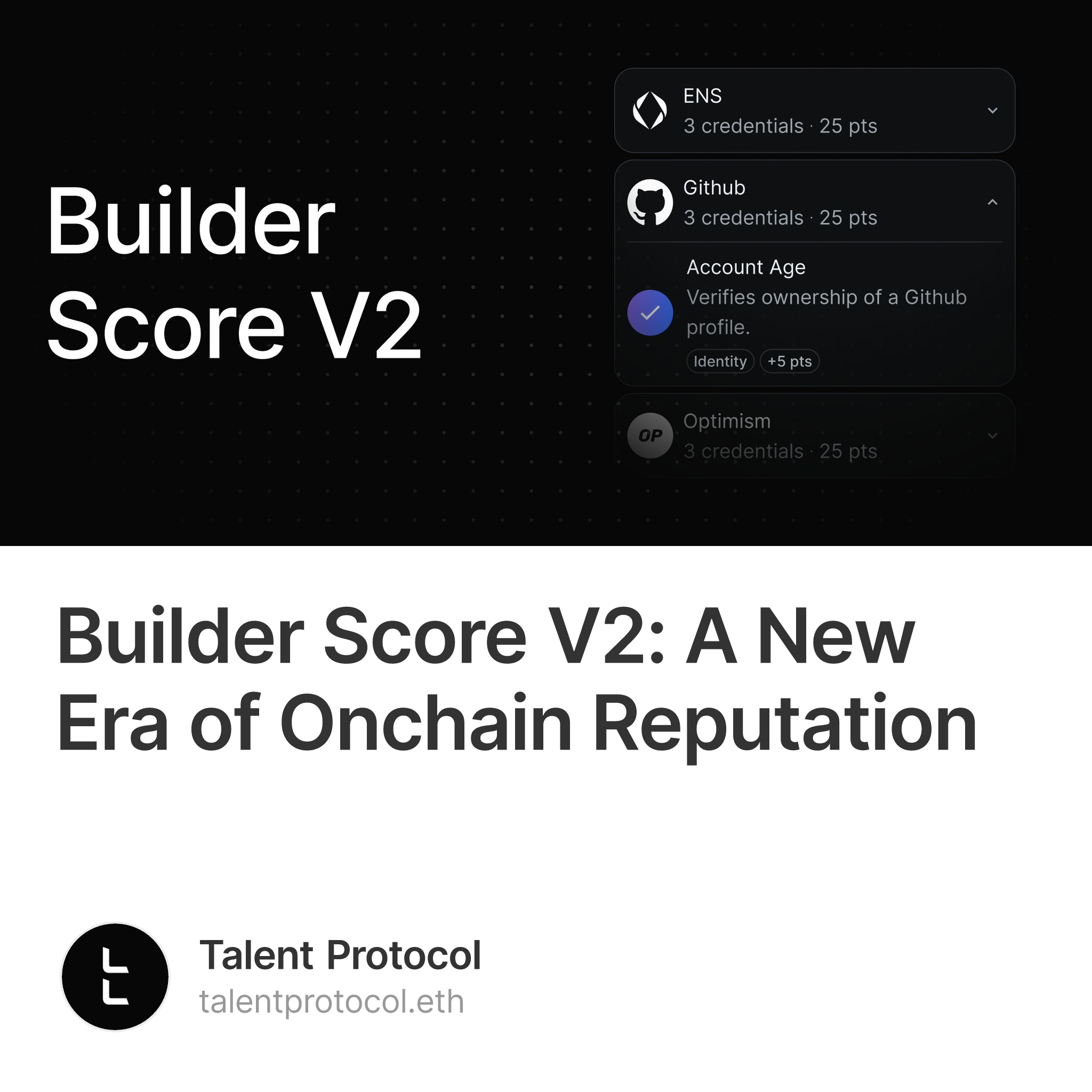Last year, we launched the Builder Score with a simple mission: help onchain builders reveal their reputation.
Since then, hundreds of thousands of builders have been verifying their reputation data to stand out in a noisy industry, while protocols like Base and Etherscan have integrated Builder Score to add reputation context to their apps. It's becoming both a tool for builders to prove their value and a standard for protocols to identify real builders.
A Growing Protocol
In less than a year, Builder Score has become the standard for builder reputation onchain:
-
Over 7 million accounts indexed
-
60+ ecosystem apps integrating our API
-
30K+ paying users
-
70K+ token holders believing in our vision
These numbers tell a story of rapid adoption, but we knew Builder Score could be better, so we went back to the drawing board.
We reimagined the Builder Score from the ground up, refining its scoring accuracy, making it more transparent, and ensuring it scales as we grow. Our goal? To make Builder Score 100x better than LinkedIn at identifying real builders.
Today, we're excited to announce Builder Score V2 – our biggest protocol upgrade to date. Over the coming weeks, we’ll be gradually rolling out the new Builder Score, alongside a revamped profile UI, new data points, and upgraded API endpoints.

Why a Builder Score Revamp?
The first version of the Builder Score was a strong proof of concept, but we heard loud and clear from our users that it had some issues:
-
It was confusing—many assumed it was a 0-100 scale.
-
It wasn’t intuitive—points didn't always add up.
-
It didn’t provide enough context—was my score ‘good’ or ‘bad’?
-
It was too static—scores didn’t update frequently enough.
-
It didn’t go deep enough, especially data points like GitHub and smart contracts.
What's Changing?
If you're already using the Builder Score, here's what you need to know:
-
More Accurate Scores: We're making the scoring system more precise and harder to game. This helps the Builder Score better reflect genuine building activity.
-
Easier to Understand: We've completely redesigned how scores are calculated. Now you'll be able to see exactly how each contribution affects your score, making it easier to understand and improve over time.
-
Deeper Analysis: We're going deeper into GitHub and smart contract data, making it easier to distinguish good builders from great ones. More granular data means more accurate representation of your capabilities.
-
New Categories: We've reorganized how we classify reputation data for better clarity:
-
Added "Credibility" as a new category to capture general indicators of trust and influence
-
Removed category caps to let your score truly reflect your building activity
-
Refocused our "Skills" category to specifically track “Developer” contributions for now
-
In 2025, we'll be expanding “Skills” to include new builder types, starting with “Creators”. Whether you're building through code, content, or community, your contributions should count toward your reputation.
-
Under the Hood
For our power users who love the technical details, here are the major architectural changes:
-
From Credentials to Data Points: We're separating the objective data we import (Data Points) from the subjective scoring we apply to it (Scoring Systems), making the whole system more transparent and composable.
-
Standardized Scoring: To calculate a Data Point’s score, we use three components: signal strength, multiplier, and max score. This makes the scoring system more structured and easier to understand.
-
Event-based System: We are introducing Events to track how reputation changes over time, giving users better insights into their progress. Think of it like Etherscan for the Builder Score: users will be able to see not just their current reputation state, but the complete history of how they got there.
-
Human Checkmark: A new protocol primitive that helps identify real humans. It aggregates verified PoH and KYC data from trusted sources into a simple binary signal: verified or not. At launch, we're accepting verifications from Binance, Coinbase, Galxe Passport, human.tech, and World ID. The best part? This primitive is accessible to any developer through our API, making human verification a building block for the entire ecosystem.
Want to dive deeper? Check out our new documentation for all the technical details.

What's Not Changing
Some key principles remain the same:
-
Builder Score remains uncapped – keep building, keep growing.
-
No time decay – your past contributions still matter.
-
No negative scoring – we focus on what you've built, not what you haven't.
What's Next: Powering the Protocol Economy
With Builder Score V2's foundation in place, we're getting ready to introduce $TALENT as the native currency of our protocol economy. Here's how it will work:
-
API Access: Builders will be able to use $TALENT to access reputation data through our API, operating on a credits system.
-
Advanced Features: Pro users will be able to build custom scoring systems and unlock increased rate limits with $TALENT.
-
Protocol Rewards: part of the protocol revenue will be used to buy-back $TALENT from the market and flow it back to $TALENT stakers, creating a sustainable ecosystem where $TALENT believers benefit from the protocol's growth.
Think of it as a circular economy:
-
builders verify their data and earn recognition,
-
customers access verified builder data through the Talent API,
-
and value flows back to the ecosystem through $TALENT.
This creates a self-sustaining system where everyone's incentives align.

Thank You, Builders 🫡
None of these improvements would have been possible without our incredible community of builders. Your feedback, suggestions, and sometimes frustrated messages helped us understand what needed to change.
Builder Score V2 is more than just an upgrade – it's a statement about the future of onchain reputation:
-
Based on verified data, not self-reported achievements.
-
Owned by builders, not platforms.
-
Transparent in its calculation.
-
Portable across the internet.
LFB!

